Priscilla's
Bird Photography
Photos from personal trips AND trips with
Birds of Oregon and General Science, (BOGS)
in association with Eugene's Celeste Campbell Center
provided by:
Priscilla Sokolowski
Eugene, OR



BOGS Delta Ponds on river,
September 25, 2014 trip report
I arrived late for our bird walk along the river near Valley River Center. When I got to the ponds the group was well ahead of me and out of sight. A Greater Yellowlegs was in the first pond; a very long pond with its long axis running parallel to the river.
The bird was at the far end of it but it was soon scampering towards me. I waited and it came up to the island which gave me the opportunity to get some pretty decent photographs of it.

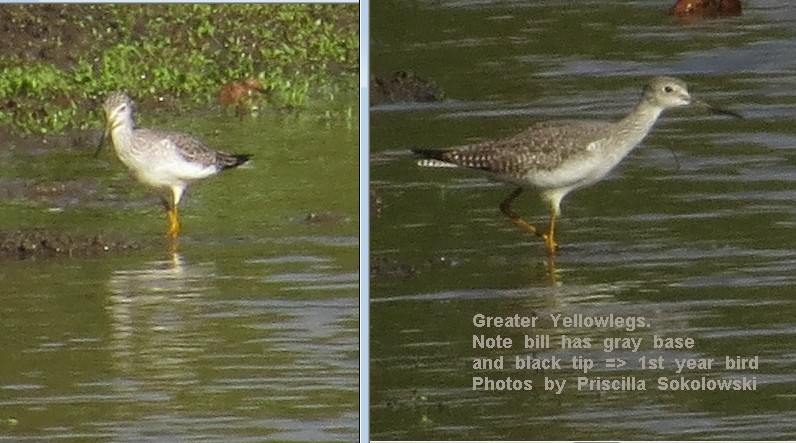

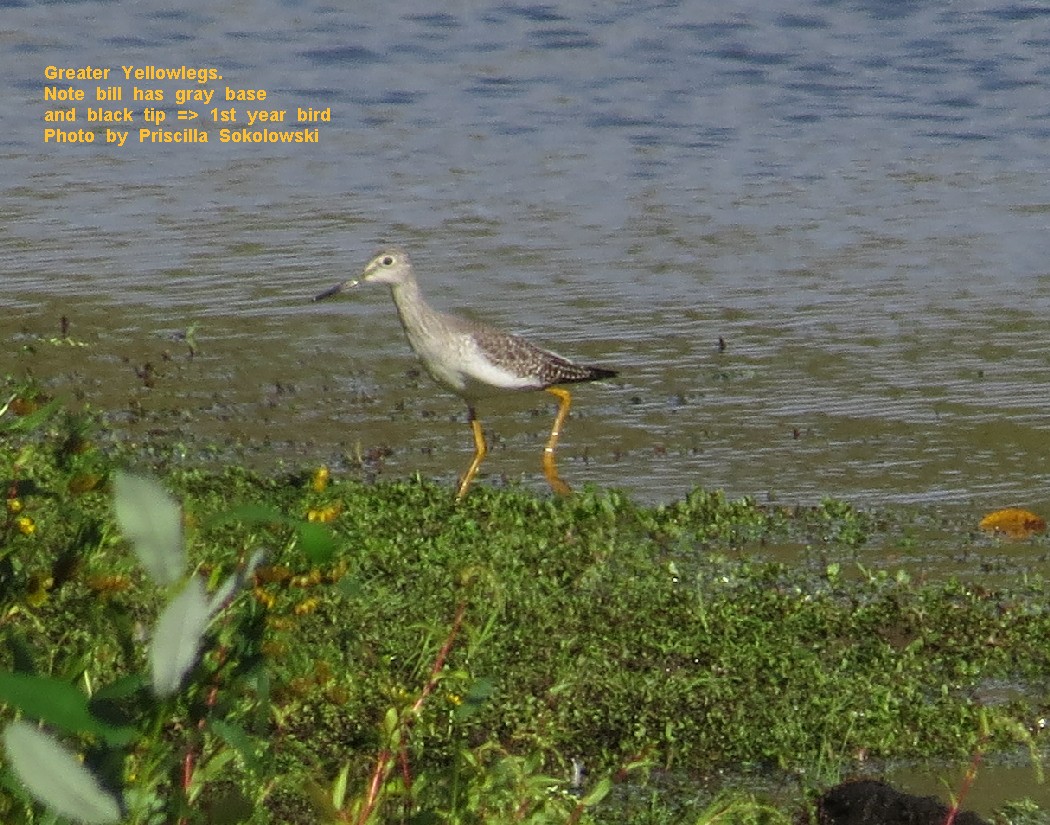
While reviewing the photos with Jody after we returned to Campbell Center, Jody (with her great eye for details) noticed that the bill on this bird was half gray and half black, the black being the outer half toward the tip.
That makes this bird a first year juvenile.

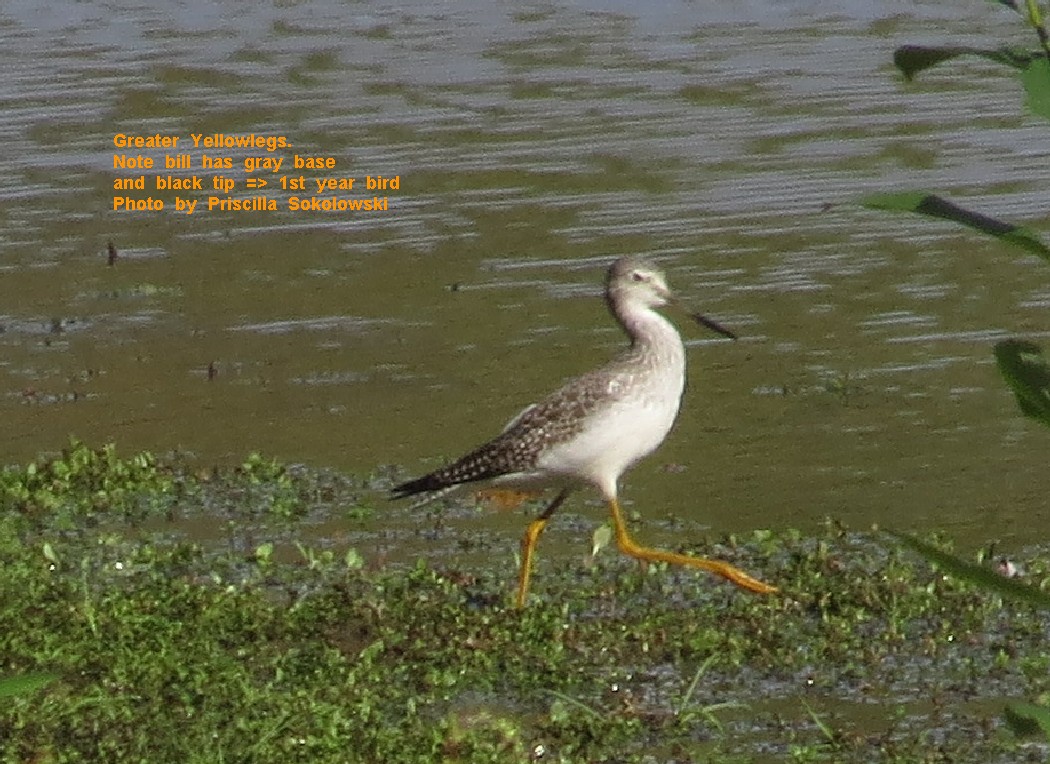
In the 2nd pond from the river, which I call the "mudflat pond" because when the water levels first begin to drop it is the first pond to become nothing more than a channelized stream surrounded by mudflats, there were Wood Ducks on parade.
I had the impression some of them were showing off their newly selected mates, because many of them seemed to be paired up.

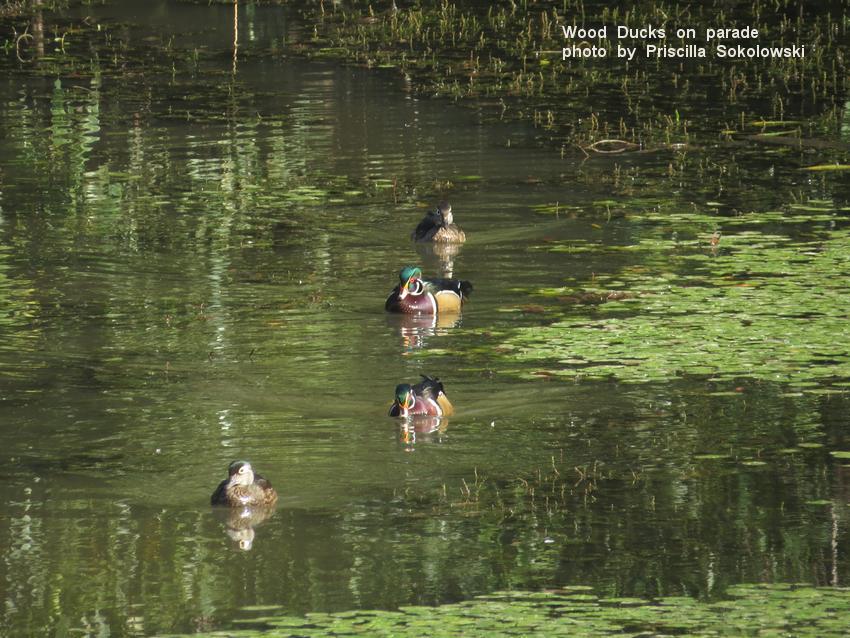

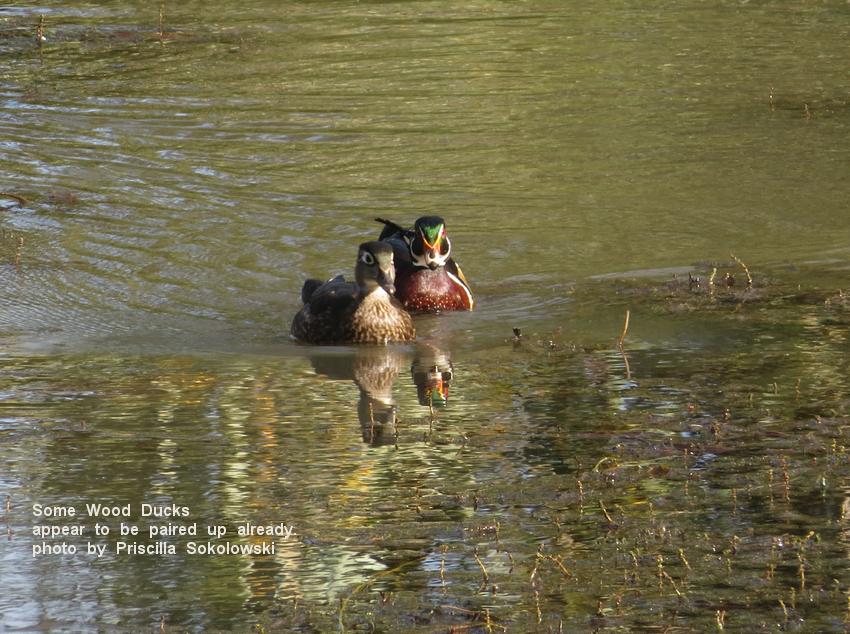


Delta Ponds is a highly exceptional place to enjoy Wood Ducks. They are far less reclusive here than most other places one might look for them. Rick Ehrens says it is because several generations of them have been raised in these ponds with nearly constant human traffic of all sorts all day long.
The male Wood Ducks can be seen up close if one visits in the morning, but as the day progresses they usually shift to the farther sides of the ponds. And in the morning, one has the Sun to one's back, which makes the irridescence of the ducks all the more intense.

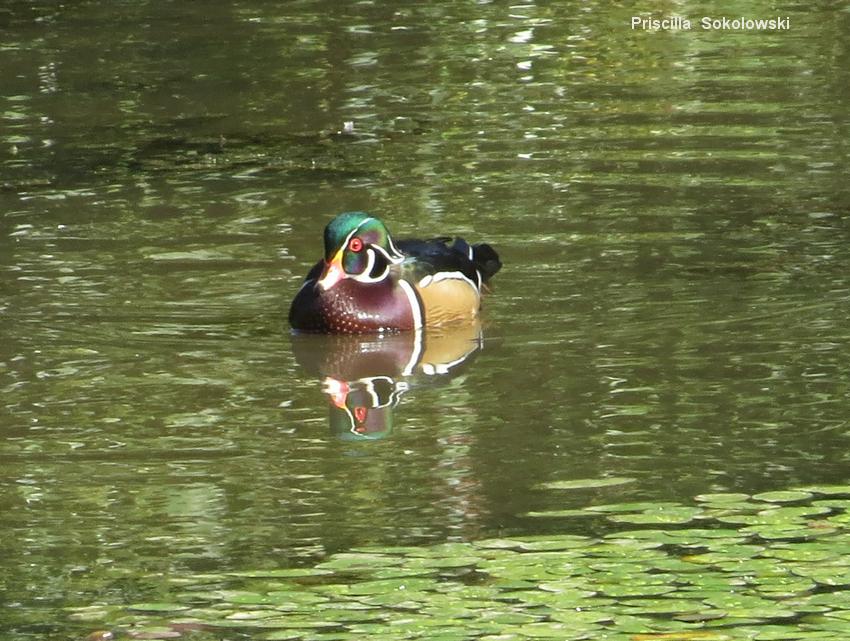

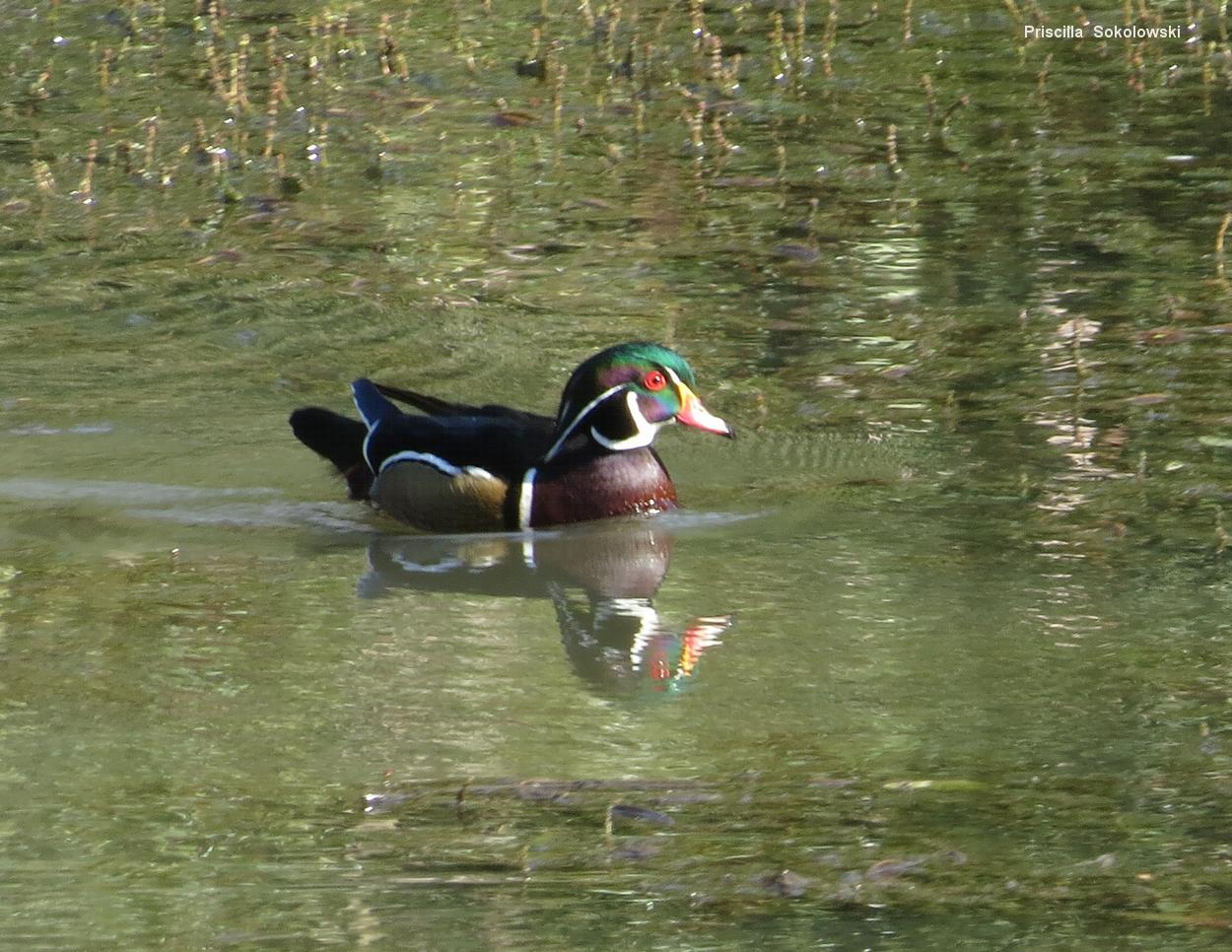
After taking photos of the Greater Yellowlegs and the Wood Ducks, I finally caught up with the group. It was 10:15 by this time.
As you can see from this photo, the group was pretty large that day. Looks like more than two dozen birders, all busily looking at Red-breasted Sapsuckers, which were gone by the time I got up to the group.

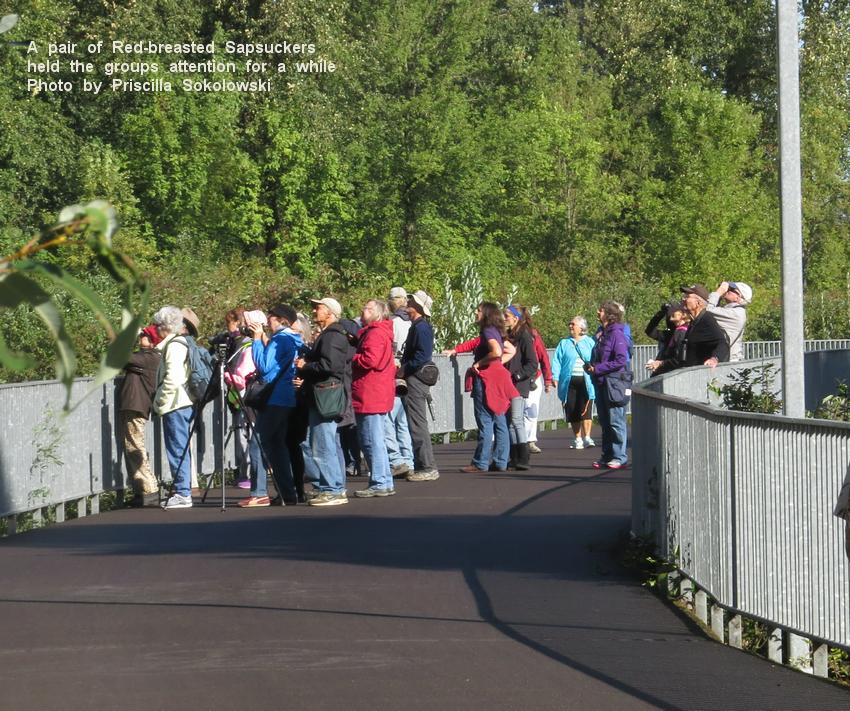
When I caught up with everyone, they were looking at one or two Red-Breasted Sapsuckers and some Northern Flickers, Robins and at least one juvenile Cedar Waxwing.
Neither Don nor I got photos of the sapsuckers, but we got photos of one sort or another of everything else.

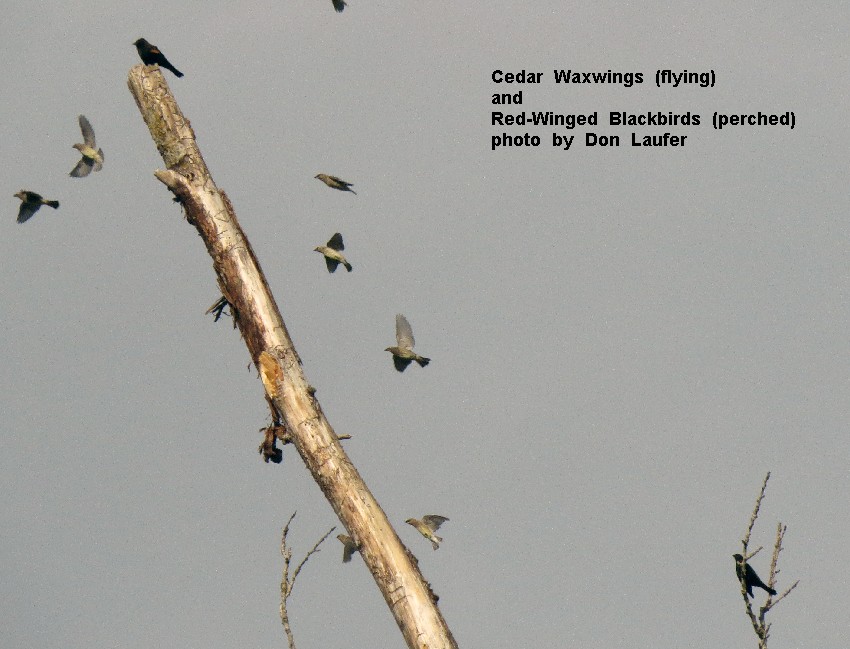

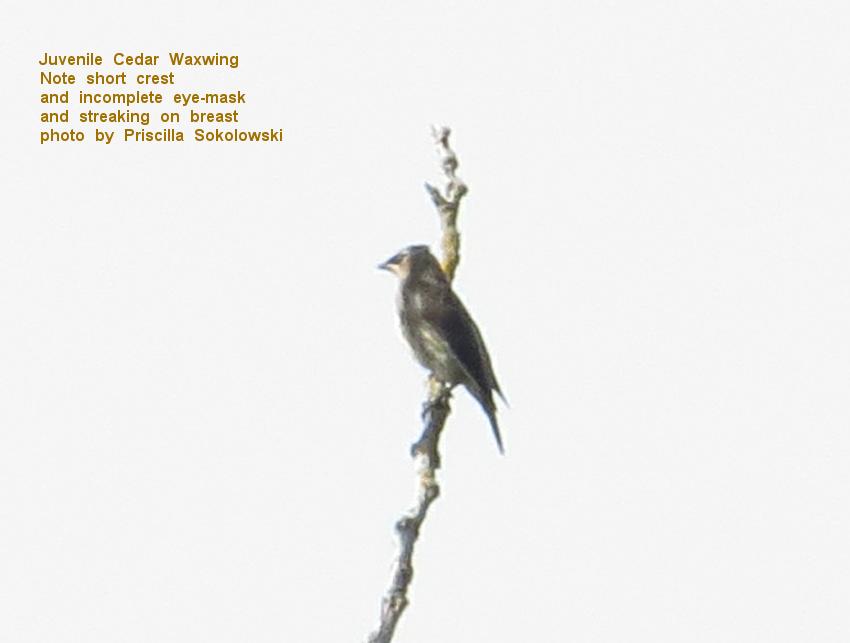

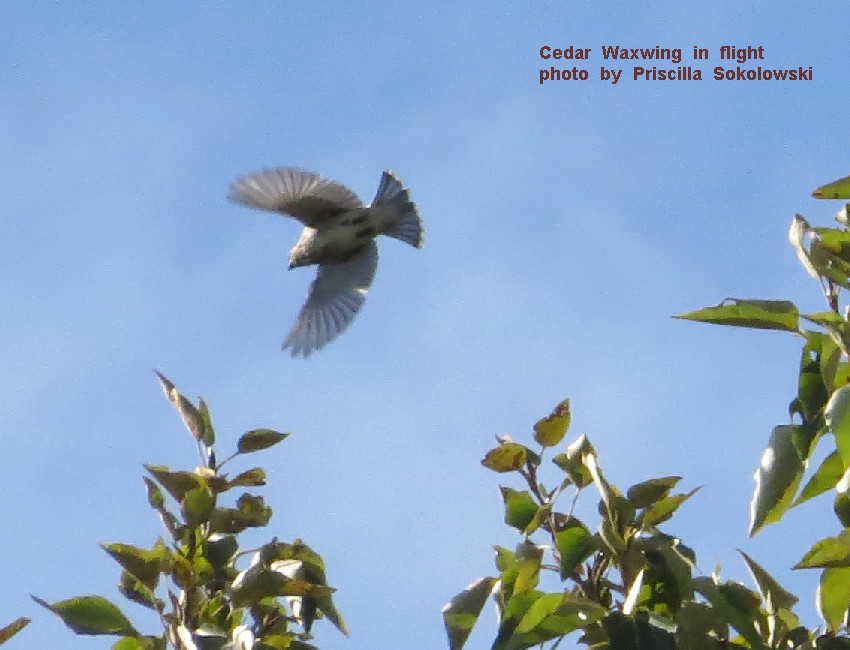

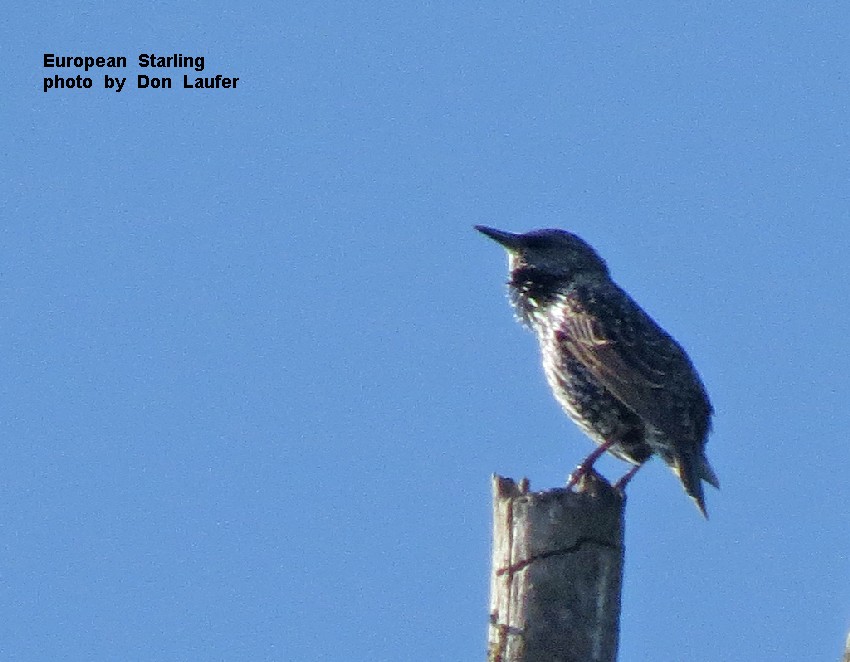

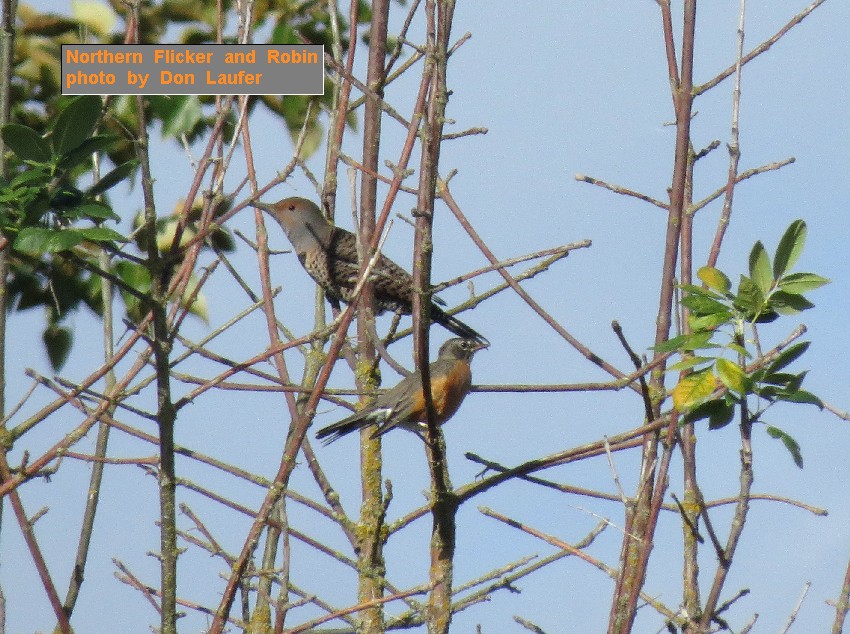
Before I arrived, Don Laufer had taken photos of several birds which I missed seeing. The best of these, in my opinion, is the Black-Throated Gray Warbler



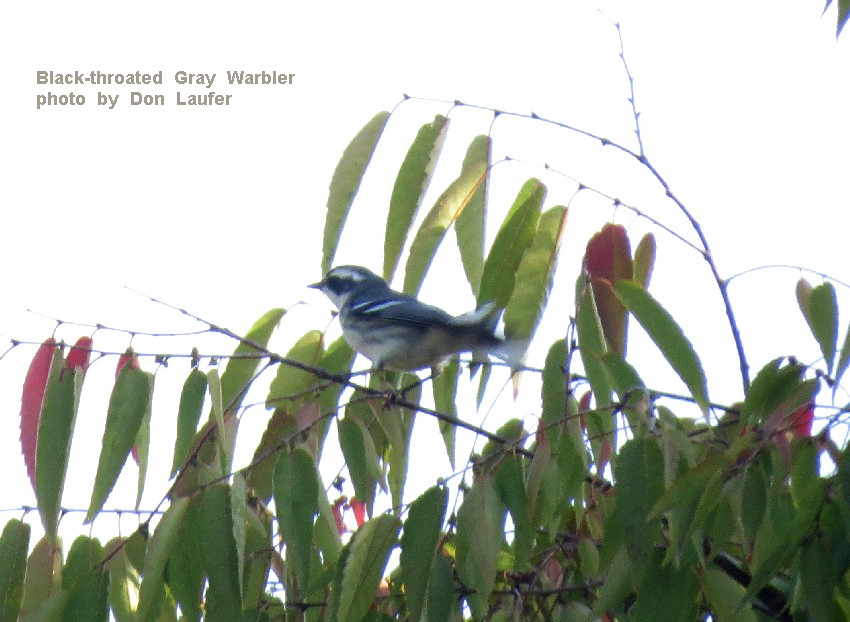

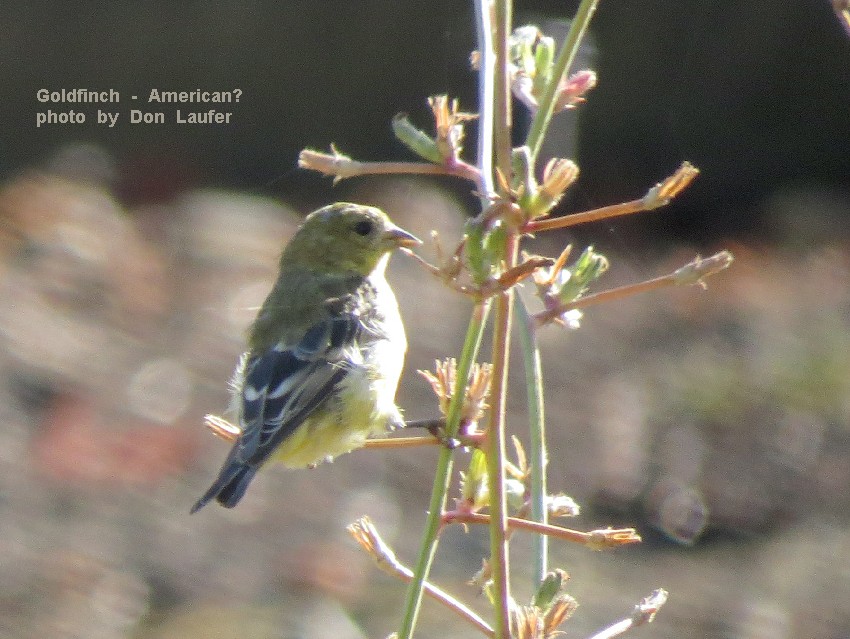

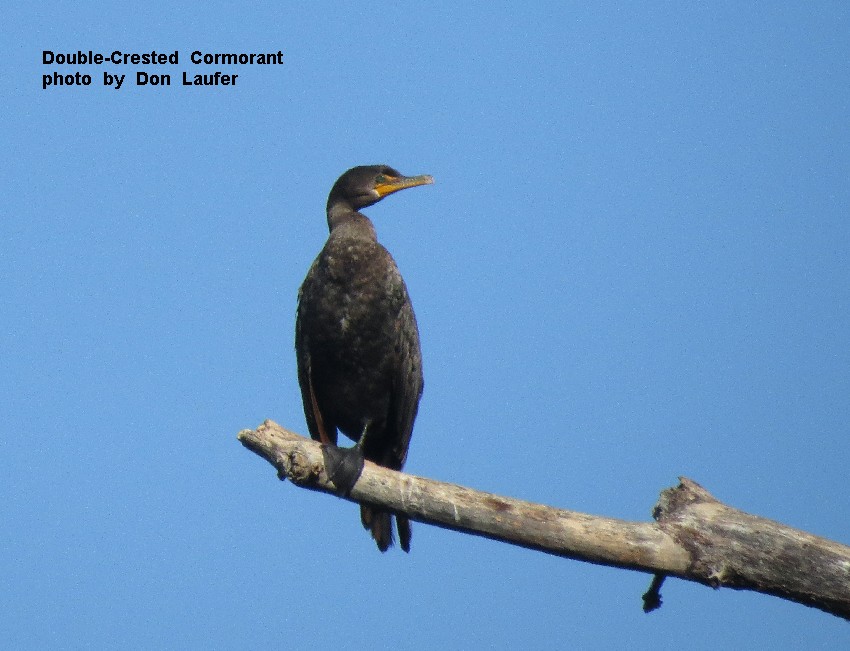
As Steve said at the time, we got about as close as one is ever likely to get to a Green Heron. We enjoyed viewing this bird at a distance of about 15 feet.
Amazingly, our entire group of around two-dozen people filed past, and not without quite a bit of excited talking, yet this bird stayed perched right where it was the whole time.

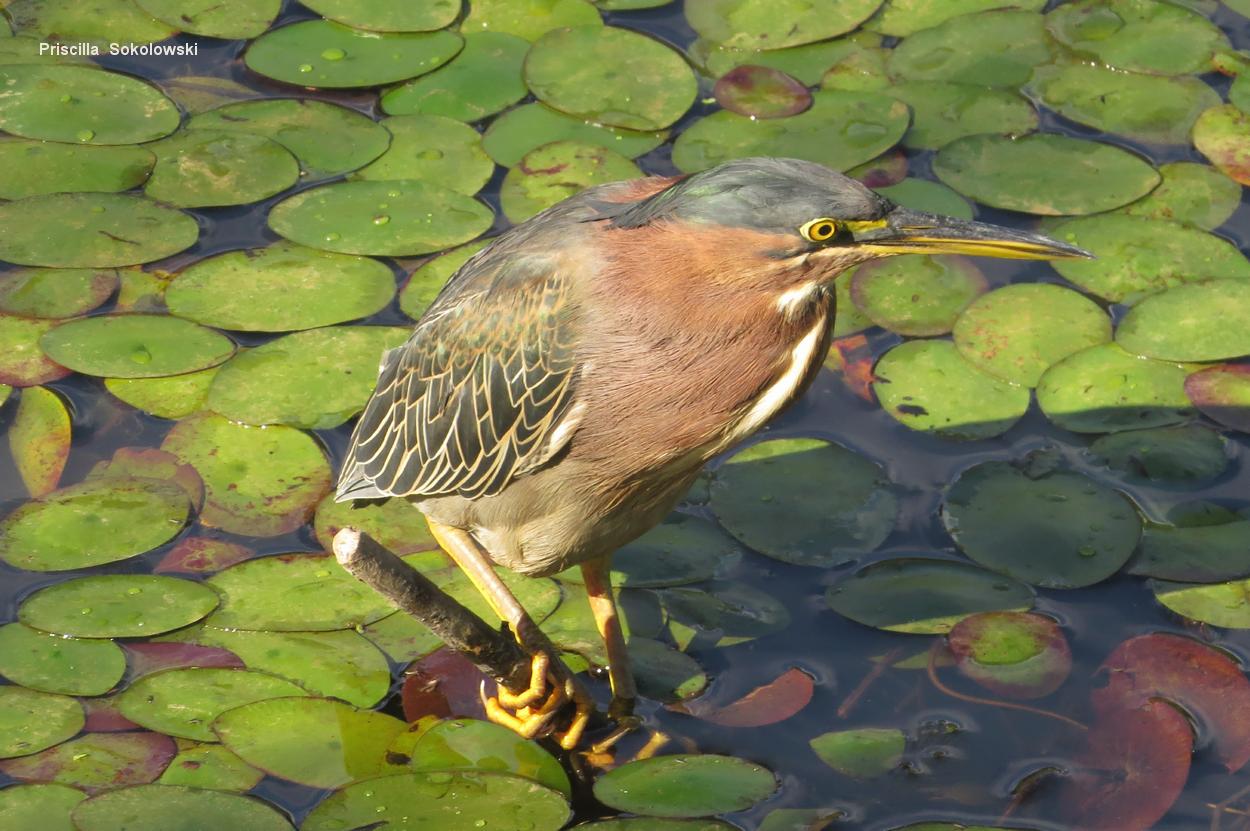


It's possible that the Heron was looking up at a Bald Eagle which was flying overhead. Don's photos of the two were taken within a minute of each other.

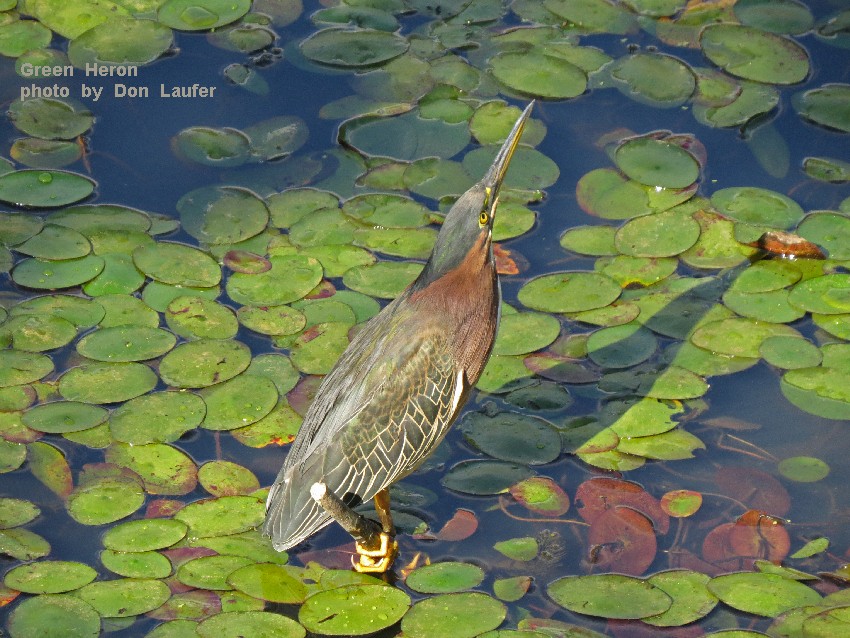



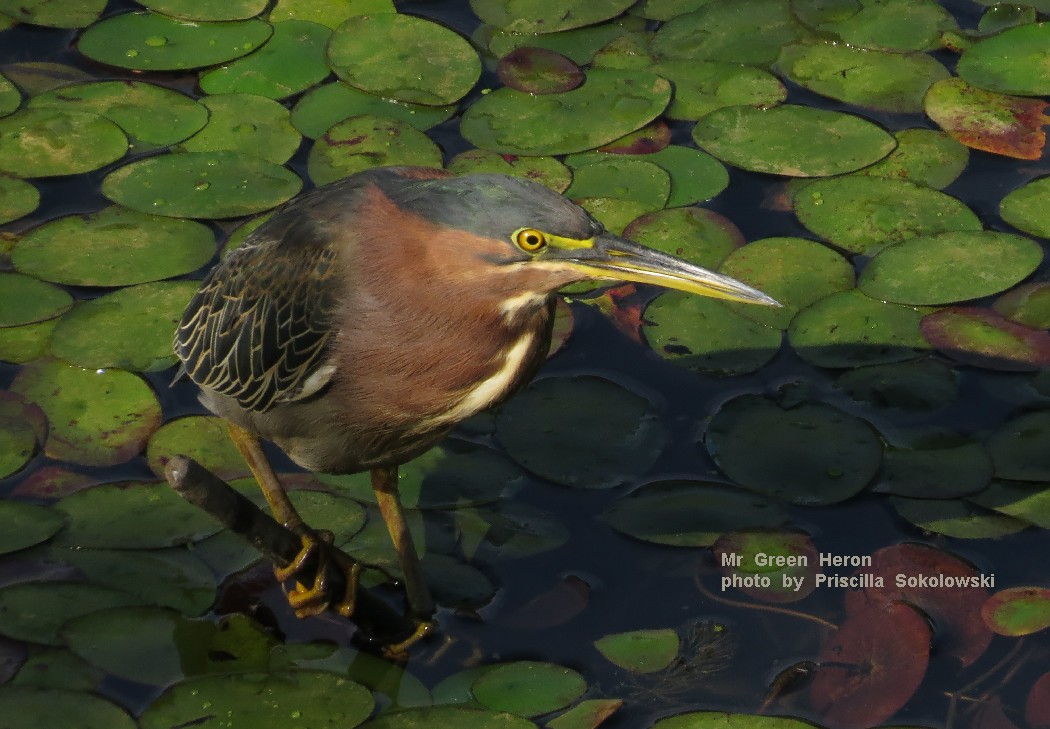
These Green Heron photos raised some questions for me which I took to several expert birders and photographers. In the cropped close-up below, you can see that there is a definitely a lack of sharpness in the shorter feathers. This is not due to motion, nor too short a depth-of-field. It originates in some way from the feathers themselves, and from the light that is leaving them and coming to the camera.
You can see green in some parts of the fuzzy region. In fact, I notice that some of the green irridescence comes right out of an area which "should" be a tan-colored edge of a feather. I've put circles around two such areas.
The green showing up in these tan areas obscures the tan edges completely in some places. Notice that, in contrast, the wing feathers below the fuzzy region appear to have very clear, sharp edges.
That in itself partially answers one of my questions. I had been wondering if the phenomenon of irridescence in itself might make it difficult or impossible sometimes to get very sharp details in that area of a photograph. Clearly that is happening here!

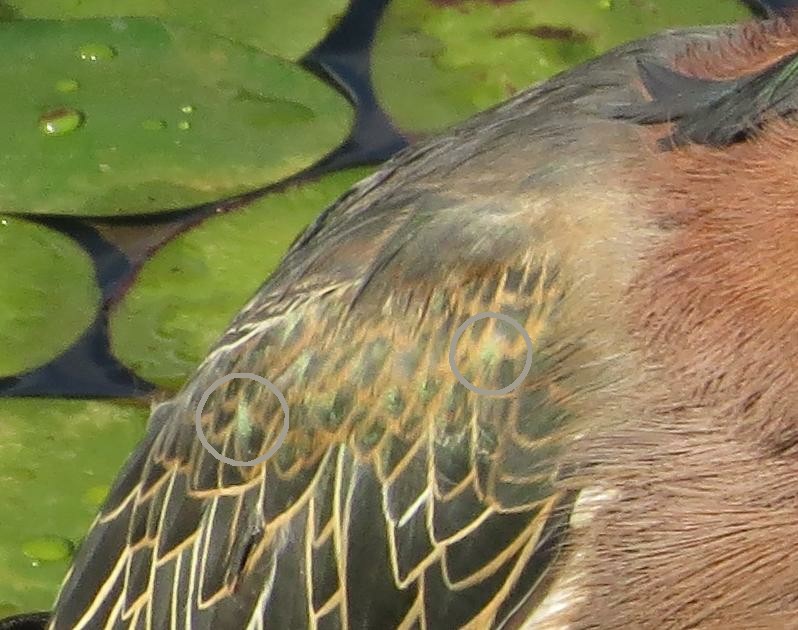
Now, the Green Heron does not actually have any feathers which are green. However, sometimes green appears on the head and wings of this bird. As with many birds of color, the colors we see are due to a phenomenon called irridescence.
There is some nice material about irridescence on the following webpage:
causes of color
There is a lot more information, both interesting and well written, though in some places a bit more technical,
at:
Iridescence: a functional perspective, a paper in the Journal of the Royal Society
Irridscence is color which often arises at least in part from light waves reflecting from two different surfaces which are close enough together to make the light coming from them out of phase just a portion of a wavelength. There is usually some diffraction involved too, which separates out white light into a spectrum - the colors are spread out over a region - as seen with a prism.
The diffraction separates the colors from each other, and the reflection of these colors
from surfaces extremely close together leads to the irridescence;
(cancelation of all but one or a few wavelengths (colors).
As I understand it, the reflected light waves interact (constructive and destructive interference), and the result is only one wavelength (color) of light survives and goes to the eye of the observer (or camera).
All this requires an extraordinary amount of very ordered physical structure at the molecular level, in the surfaces which are reflecting the light. There has to be something equivalent to thin films or rows of structure which act like multi-slit gratings.
Green light for example has a wavelength of 510 nm, (five one-ten-millionths of a meter). For diffraction and/or irridescence to occur, the physical structures of the feathers involved must be on this same order of size. Just to give some size comparison, some bateria, and some mitochondria in cells are about 500nm in size.
Viewing from a slightly different angle usually results in an entirely different color because of the geometry and different path lengths taken by the light, leading to slightly different cancelation (destructive interference). A great example is a Hummingbird's throat, which can be brilliant red, then green or black when seen from a slightly different viewing angle or slightly changed position of the bird.
What I do not understand is why only a few colors show up from this process. One does not usually see the entire spectrum of colors as one changes viewing angle. With a Mallard Duck's head for example, on sees either brilliant green, or sometimes deep blue or else black, but rarely any other colors.
There were, of course, other birds to see and photograph. I think Steve said this was a juvenile Great Blue Heron.

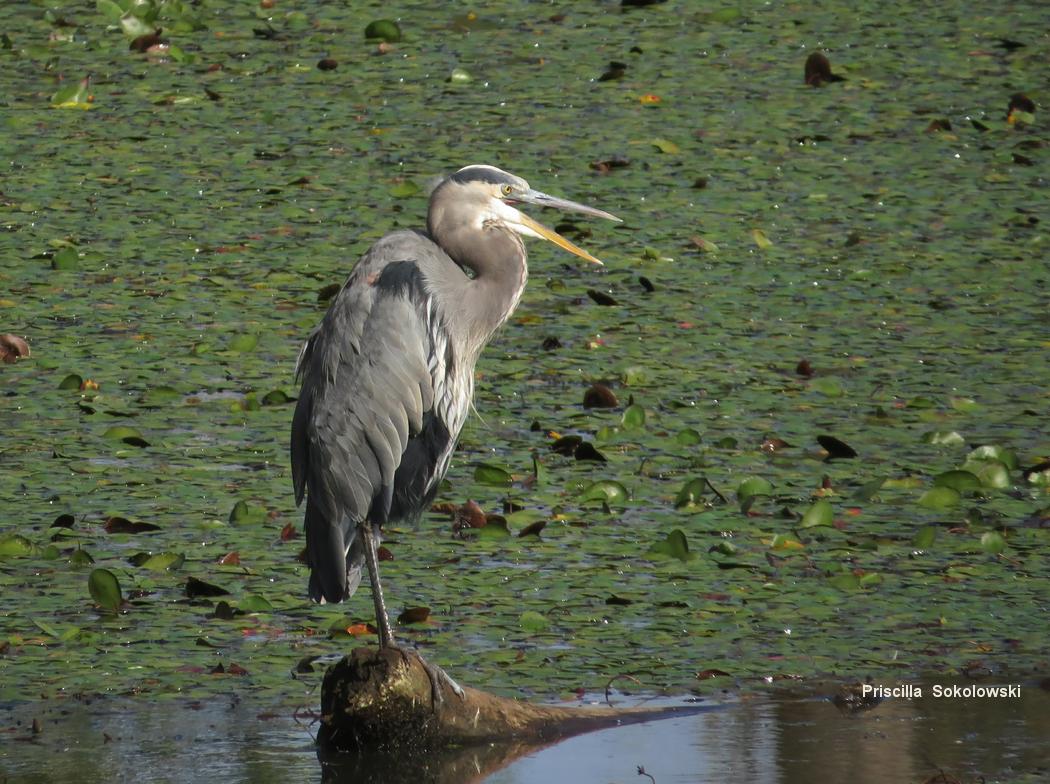
While many of the Wood Ducks seem to be in pairs, there are quite a few "extra" males around too, and some of these seem to be hanging out with paired-up ducks. Sort of an "Uncle-Ralph" companion perhaps. Or maybe the pair is not really a pair to begin with.

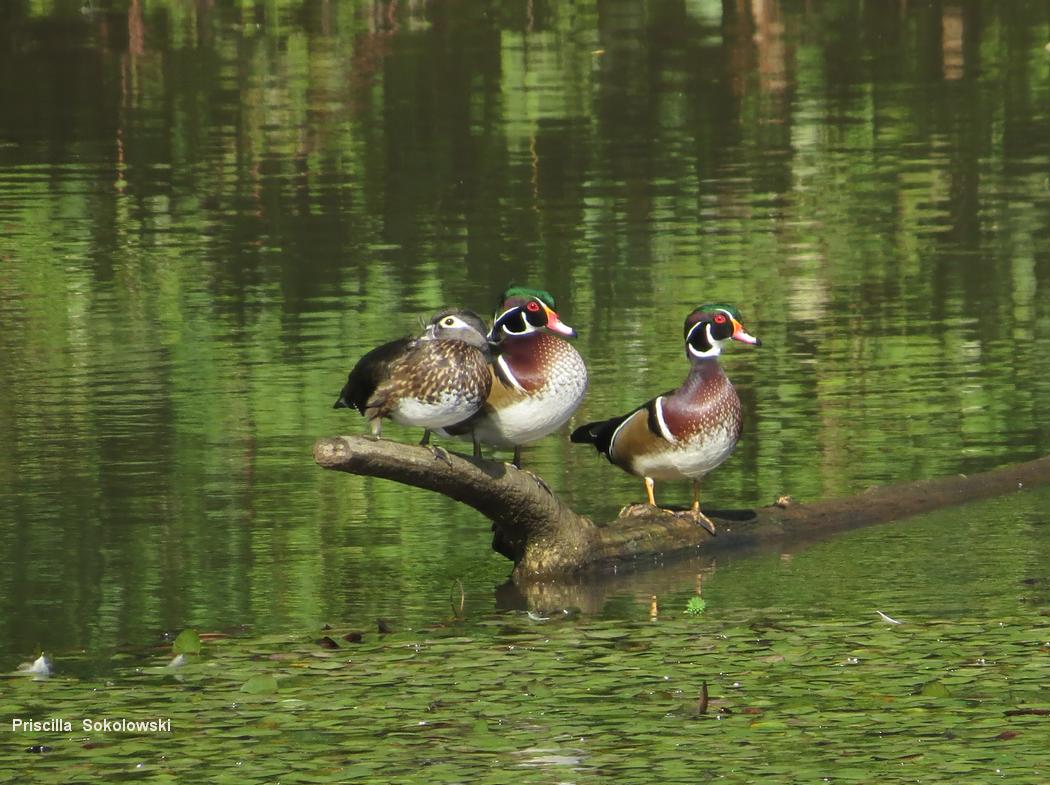
There was a lot going on nearly all the time. Our group was so large that some sub-groups were looking at ducks near the culverts; another handful of people were looking at Jays around the pond on the other side of the path (near the culverts); while yet another handful of us were looking at a flock of Common Bushtits in the bushes along the bike path.
Don and I worked on photographing the Bushtits because they were pretty close to us and there were plenty of them to work with. Focusing on birds which are moving about inside the branches of bushes is always a challenge, but Don got a couple great shots when birds came out in the open. I didn't fare so well, but did manage to get something.

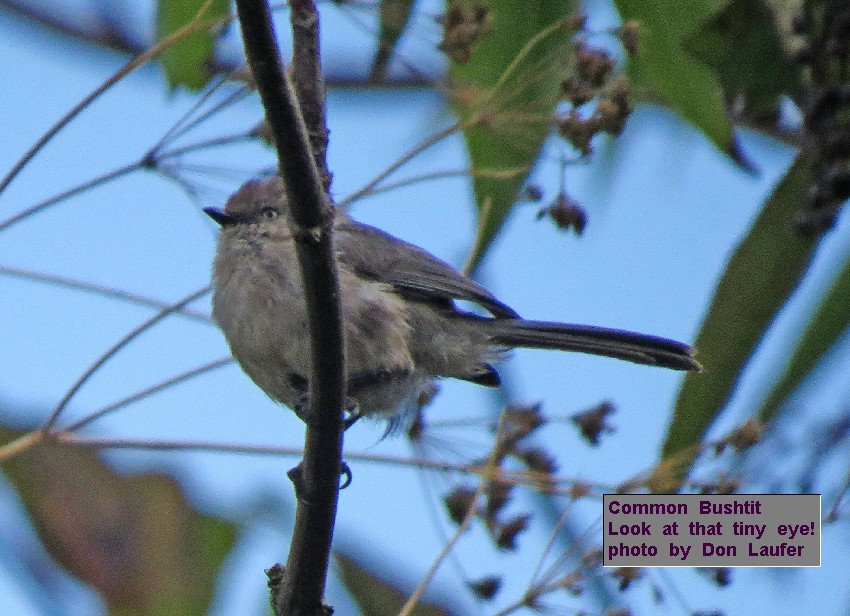

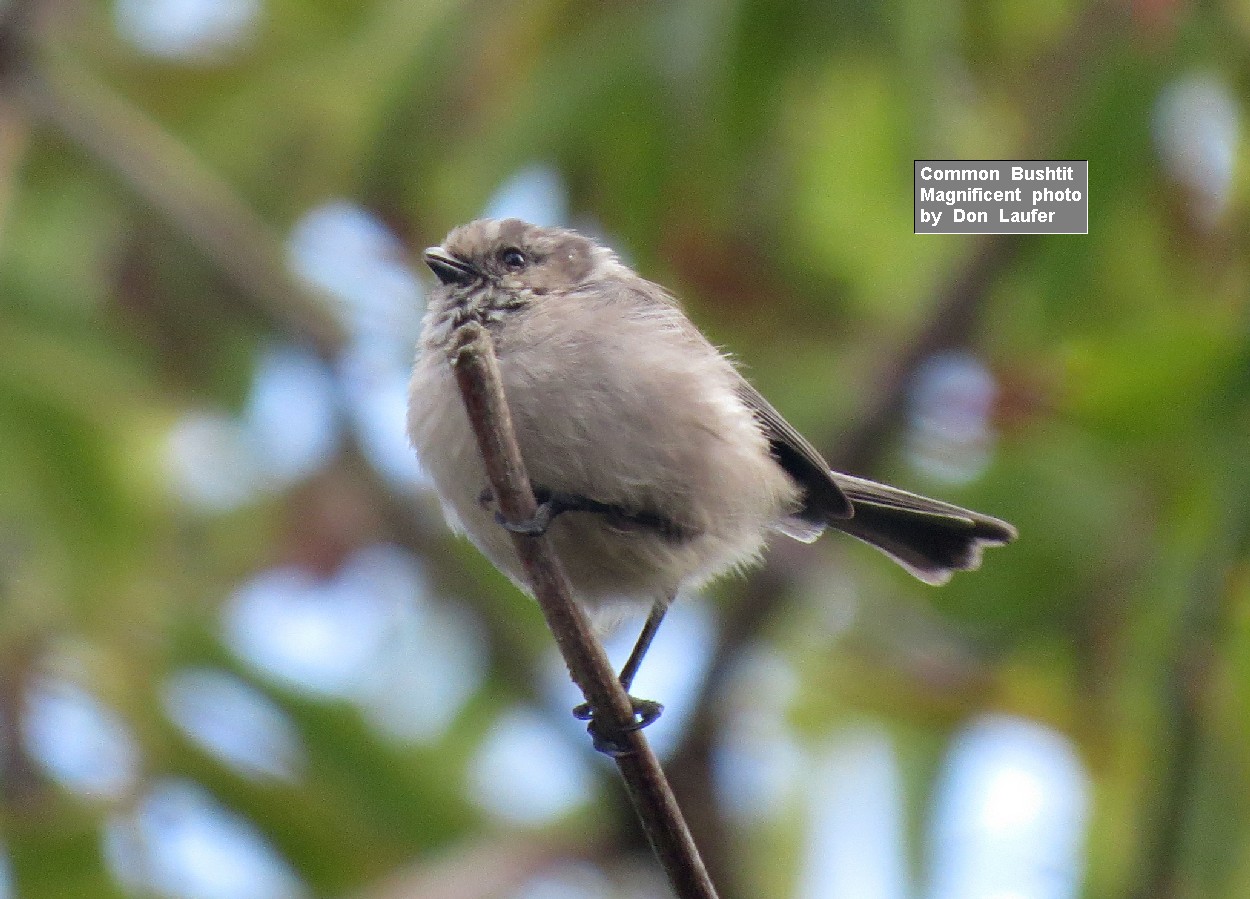
The Bushtit I was trying to focus on was kind of scruffy looking. I think perhaps it was a juvenile going through a molt.

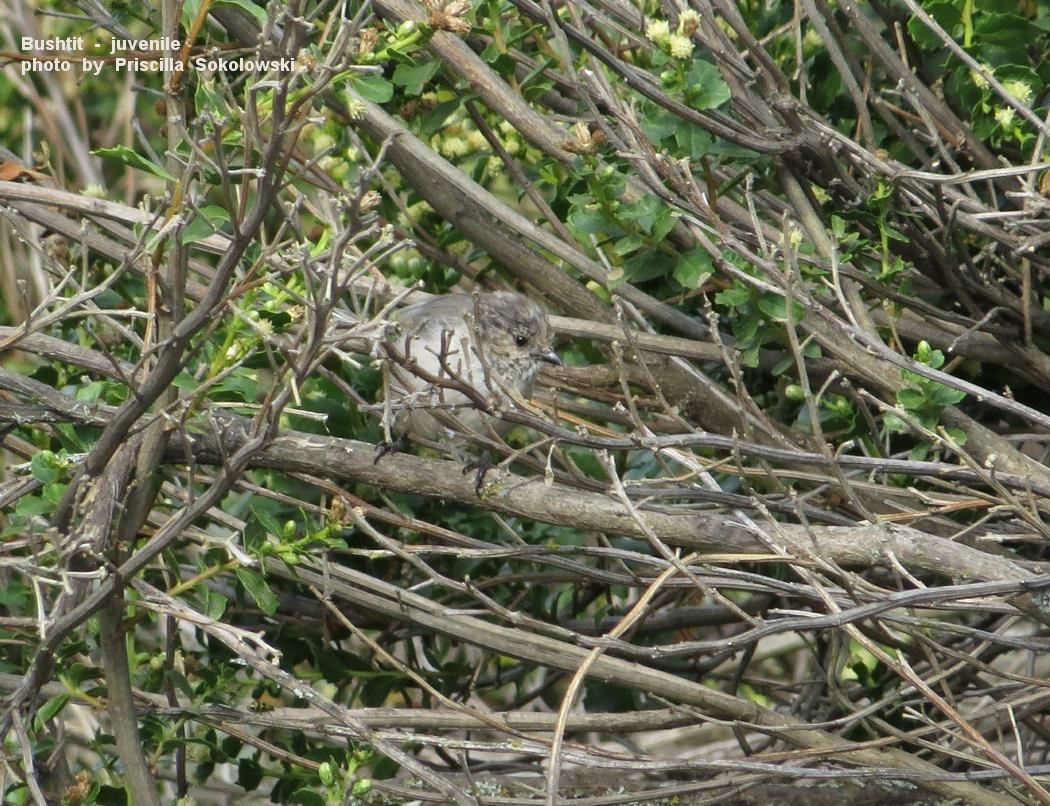

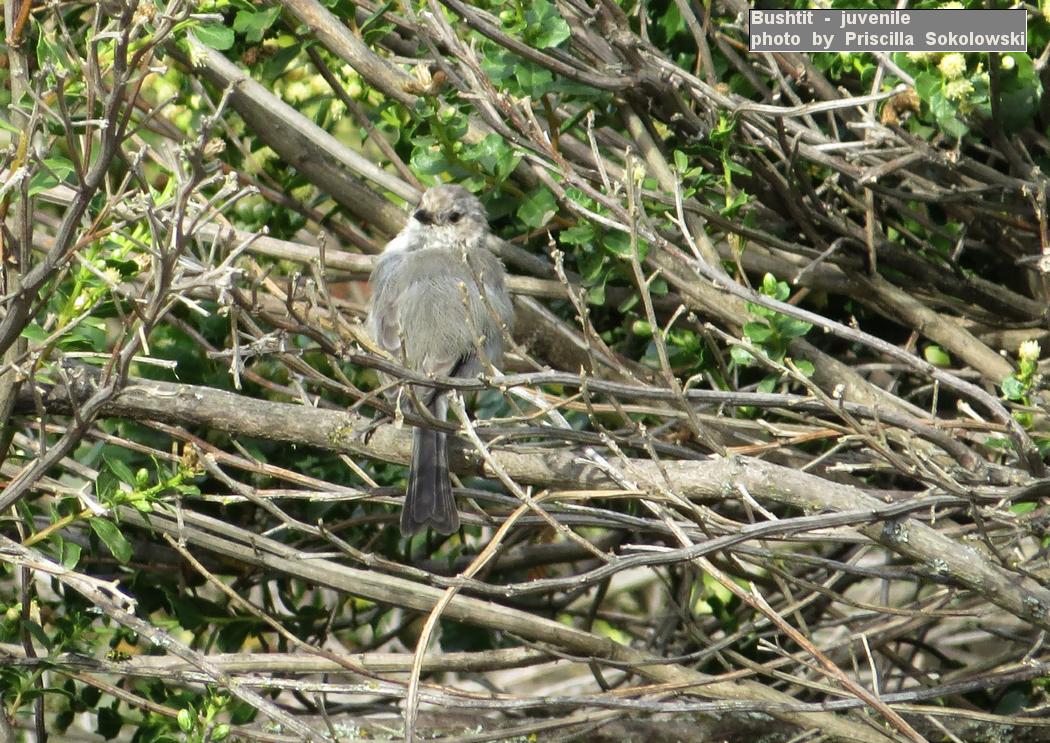
Donna was hearing a bird in the bushes off in the distance, on the shore of an island set out away from the culverts. Her persistance paid off because eventually the bird showed itself and Donna called out "It's a Yellowthroat!" I happened to be standing next to her so she showed me which bush it was in and I was able to quickly snap a picture before it flew out of sight again.

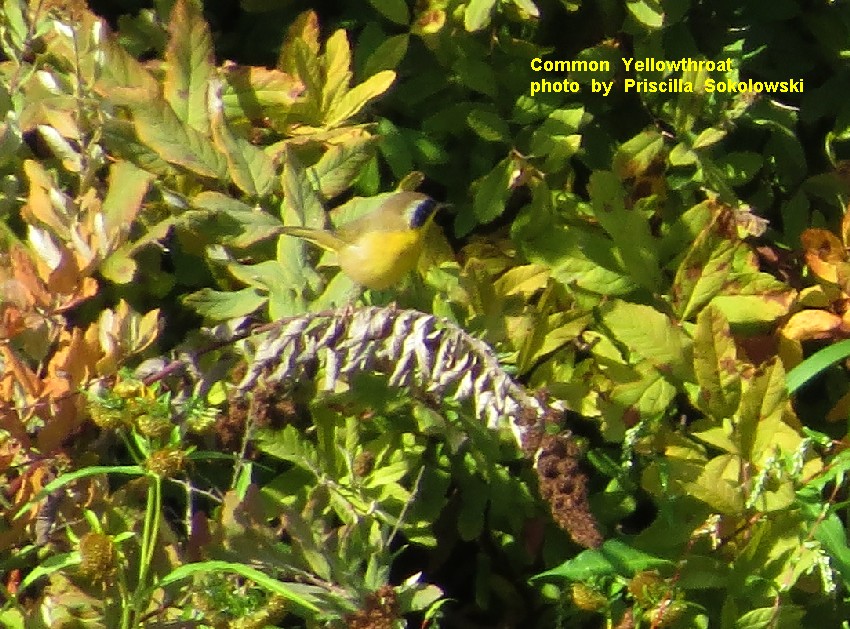
On the other side of the bikepath, out in the very large pond, we saw our first Gadwalls of the season, as well as a Pied-Billed Grebe; a bird which is almost certain to be seen here if one looks for it, and not just certain months, but all year around.

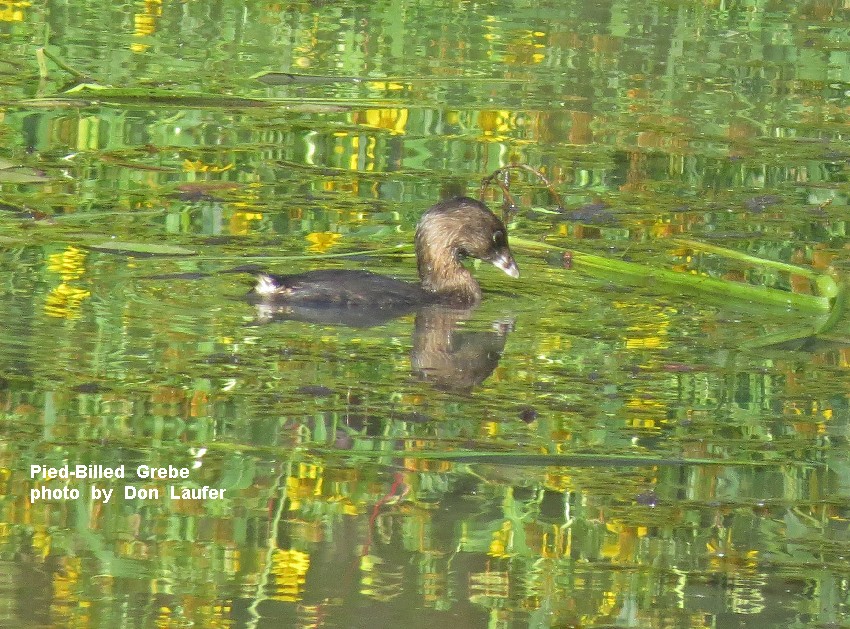

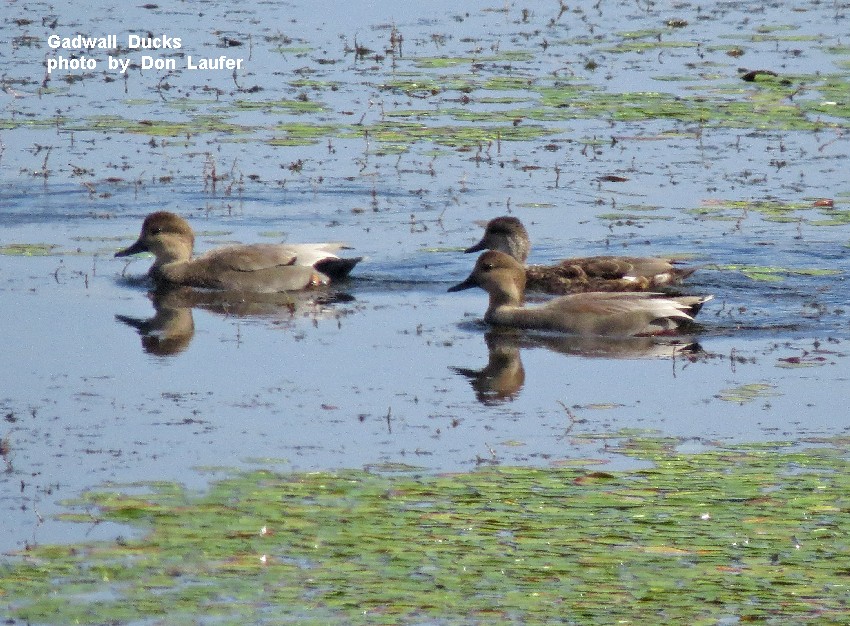

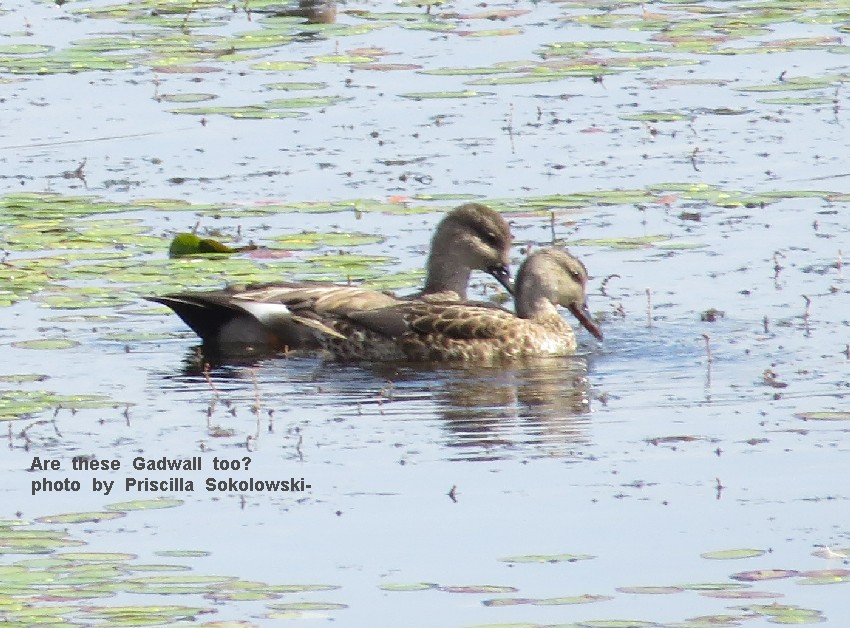
There was one Great Egret still at the ponds. A few weeks ago someone counted nine of these and they were around for about a week. The same thing happened last year. People keep asking me if these Egrets migrate and all I can say is I don't know; I haven't done any poking around about that, but I do know they have come through here in a group for these last two years.

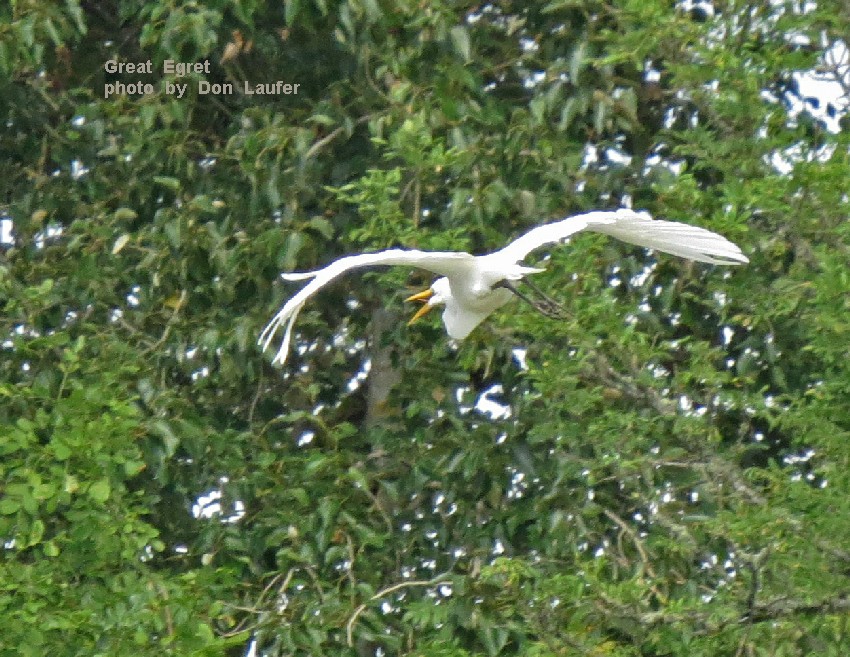
When Steve began leading us back for the return trip, one small group continued further on
to the next corner of the trail. This group reported seeing a Falcon.
Not too much later, about 1/8 mile away, the rest of us saw an immature Peregrin Falcon,
which could possibly have been the same bird. There has been an immature Peregrin
in this general area for more than a year.
I've been out at Delta Ponds two or three times a week; for about six weeks since mid-August. I have been noticing that Mallard Ducks, both males and females, have grown their breeding plumage during this time.
There was hardly a green head to be seen in mid-August, but now, at the end of September, many of the males are in full regalia. The females developed a deep rich brown coat during this same time, though we didn't get any photographs of female Mallards on this walk.

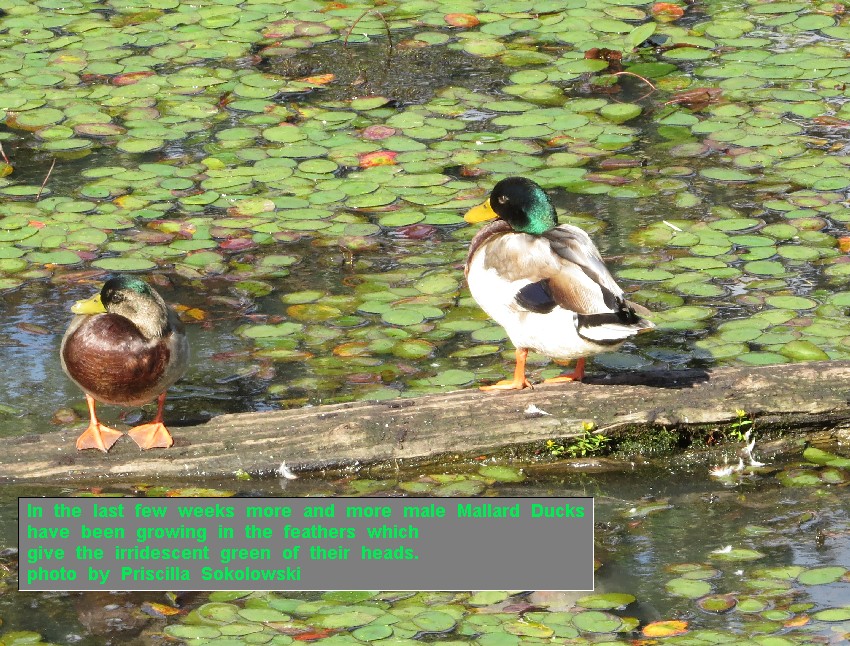
On our return path, the same area where the Waxwings, Flickers and Sapsuckers had been, proved to be equally if not more interesting. There was a Scrub Jay near the top of a bare tree, perhaps looking a bit nervous.
A Northern Flicker dove from it's perch suddenly. Then a Cooper's Hawk appeared out of nowhere and started chasing the Scrub Jay. The Jay escaped and the Hawk landed on the snag.

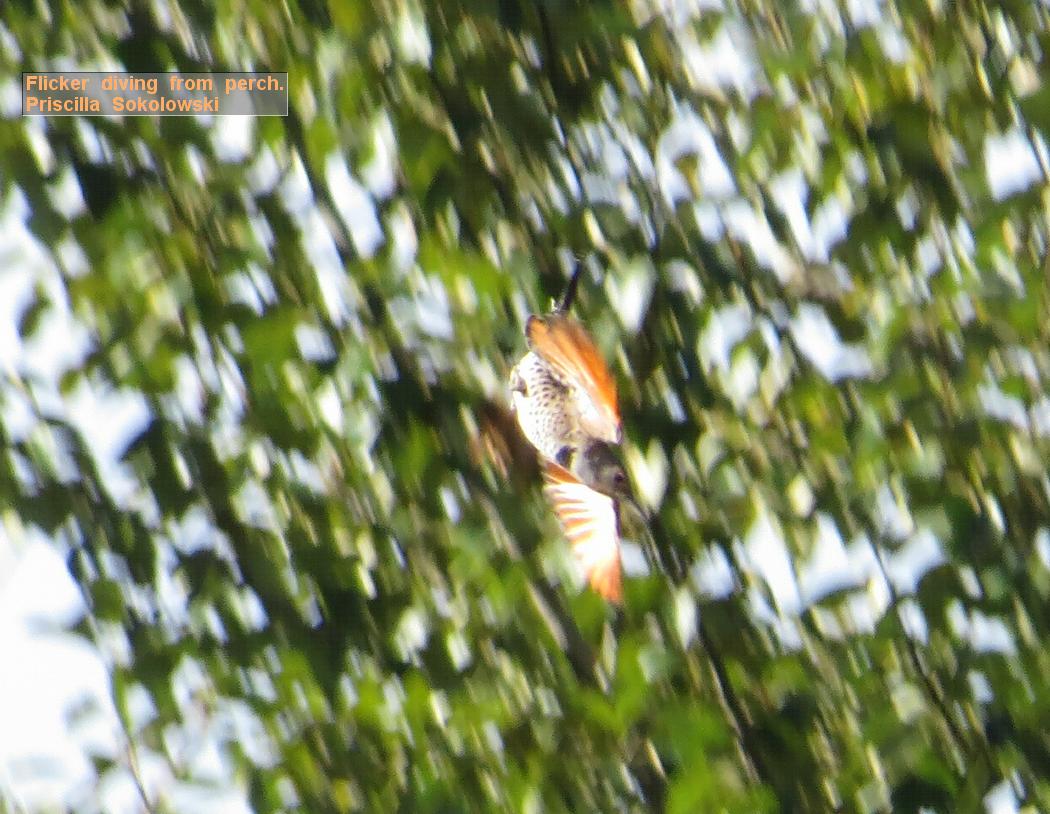

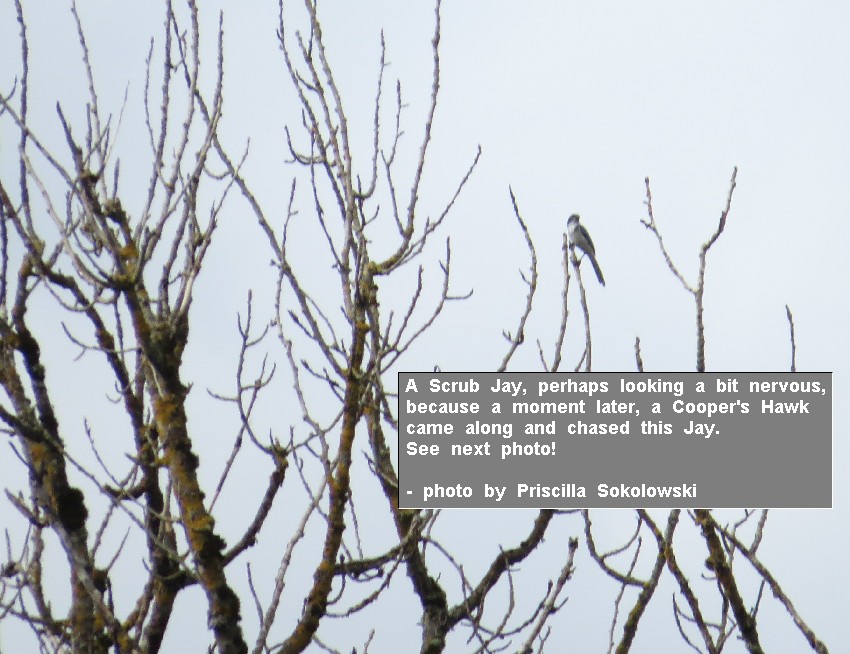

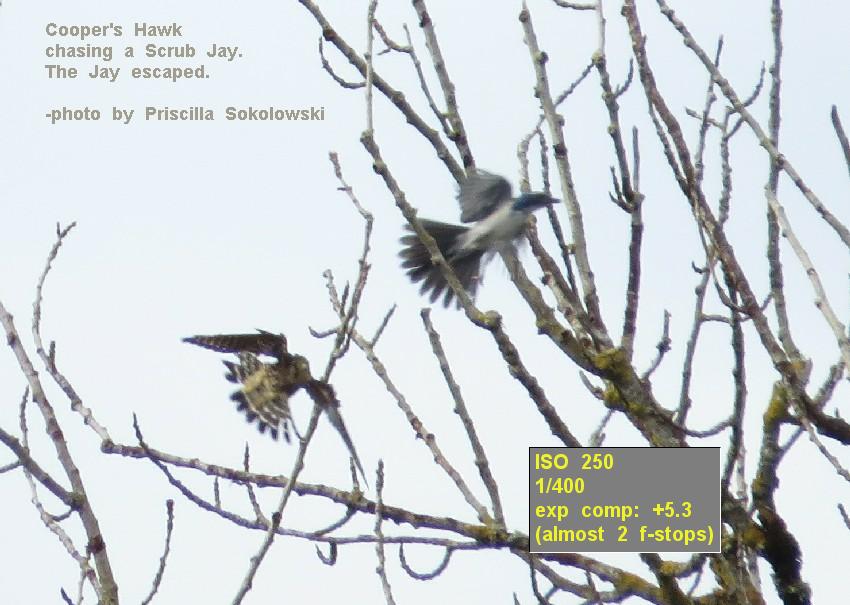

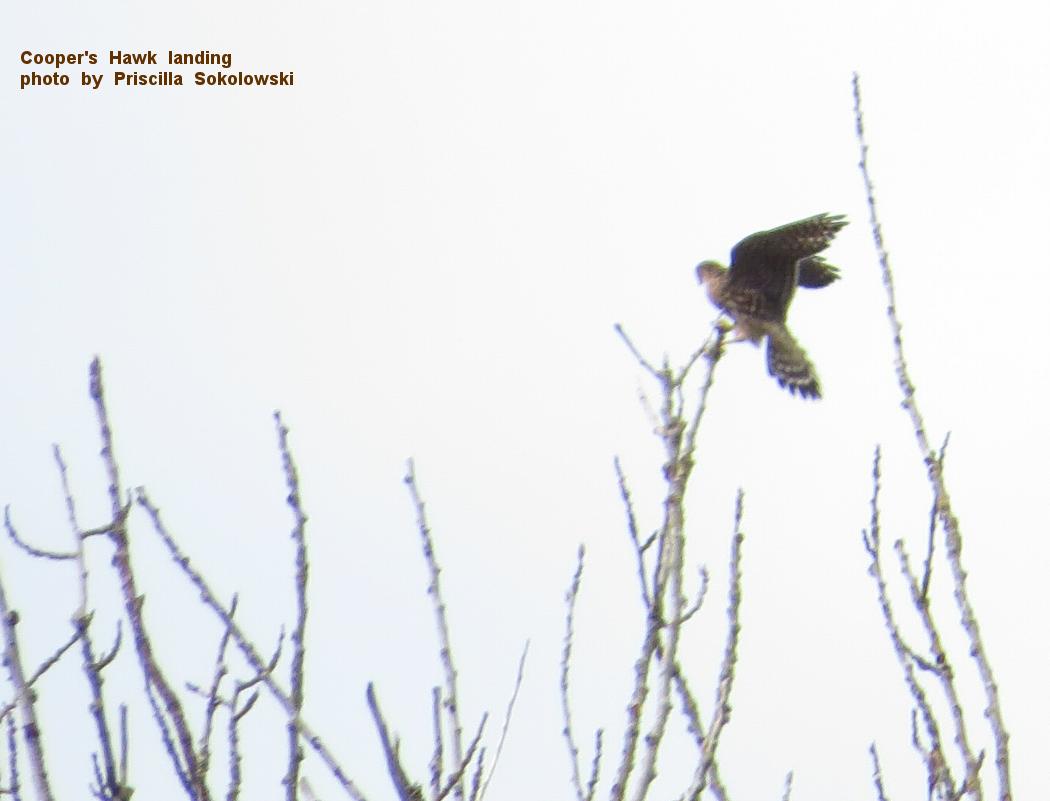
Cameras record the time a photo is taken, so I can say with certainty that within a minute, the Cooper's Hawk was gone and an immature Peregrin Falcon had taken its place. We did not know at the time that it was a Peregrin. In fact, with all the flying around going on, I'm not sure any of us even realized that one bird had been replaced by another!
Even on the camera display of a 50X photo, we could not be sure what species of bird it was up there. But upon reviewing the photos indoors later over lunch, Jody and I could see the "mustache" or "sideburns", giving us this bird's identity.

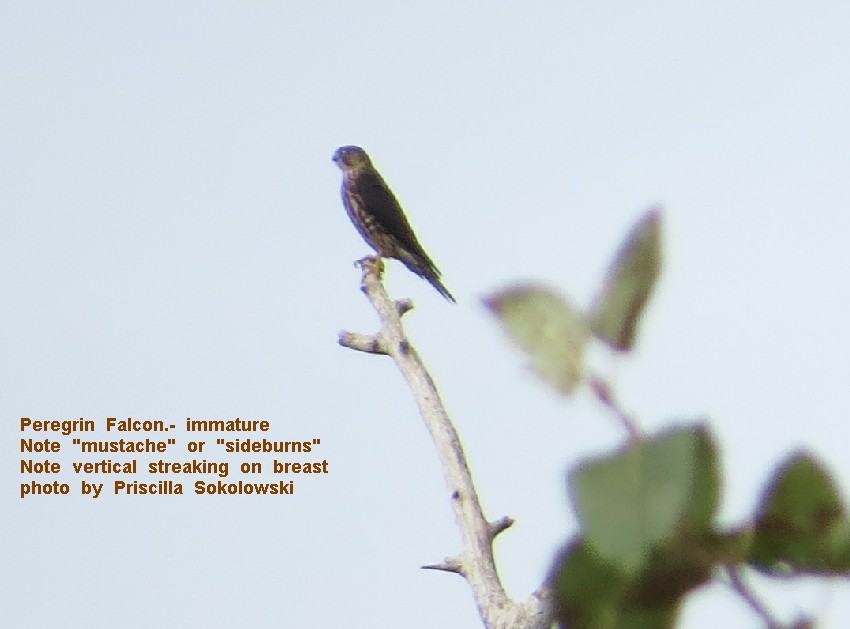
The Peregrin Falcon was being dive-bombed by another bird. The color of the wings of the "attacker" suggests that it was a Northern Flicker.
Perhaps it was the same Flicker which dove for cover just before the Cooper's Hawk came on the seen only two minutes before.

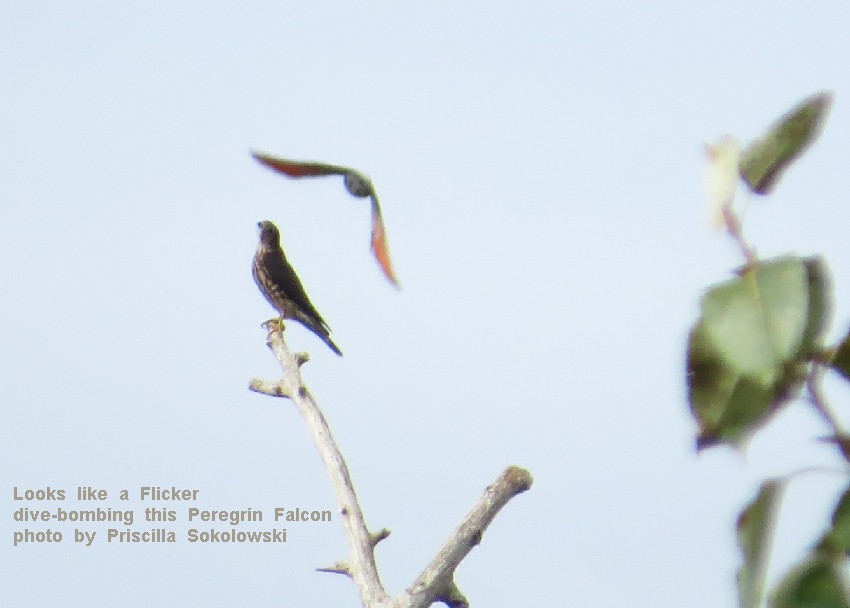
Because Doris was unable to be with us, Beth kept a record of the birds seen or heard for us on this trip. We had 35 species on 9/25/14. This is a pretty good-sized number of species!
An earlier mailing of the bird list included a Western Grebe. That seemed suspicious to me, so I checked with Beth and Steve.
Beth had heard someone saying they saw one, but when I asked Steve, he said there was no Western Grebe. I looked into eBird records and found that historically, the only report of a Western Grebe at Delta Ponds was by Tom Mickel on Feb 16, 2008, so it does seem unlikely that we would find one here.
- Violet-Green Swallow
- Mallard
- Greater Yellowlegs
- Double-crested Cormorant
- Crow
- Black-capped Chickadee
- Brown Creeper
- Bushtit
- Cedar Waxwing
- Scrub Jay
- Steller's Jay
- Red-winged Blackbird
- European Starling
- Western Grebe
- Pied-billed Grebe
- Gadwall
- Great Blue Heron
- Cooper's Hawk
- Peregrin Falcon - immature
- Wood Duck
- Bewick's Wren
- Common Yellowthroat
- Green Heron
- American Robin
- Red-breasted Sapsucker
- Downy Woodpecker
- Northern Flicker
- Turkey Vulture
- Kingfisher
- Great Egret
- Cacklers (or were they Greater White-fronted Geese?)
- Black-throated Gray Warbler
- Song sparrow
- Bald Eagle
- Falcon - possibly the same one seen near the end of the walk.
I hope you enjoyed this report and all the photos!
Priscilla